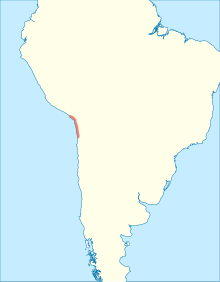
Back Чынчора Byelorussian Chinchorro Catalan Chinchorro Czech Chinchorro-Kultur German Cultura chinchorro Spanish Chinchorro kultura Basque Chinchorron kulttuuri Finnish Culture chinchorro French Cultura chinchorro Galician תרבות צ'ינצ'ורו HE
 Extent of Chinchorro archeological sites | |
| Geographical range | Atacama Desert |
|---|---|
| Period | Preceramic |
| Dates | c. 7000 - 1500 BCE |
| Preceded by | Monte Verde |
| Followed by | Wankarani |

The Chinchorro culture of South America was a preceramic culture that lasted from 9,100 to 3,500 years BP (7,000 to 1,500 BCE). The people forming the Chinchorro culture were sedentary fishermen inhabiting the Pacific coastal region of current northern Chile and southern Peru. Presence of fresh water in the arid region on the coast facilitated human settlement in this area. The Chinchorro were famous for their detailed mummification and funerary practices. The area of the Chinchorro culture started to receive influences from the Andean Plateau around 4,000 BP, which led to the adoption of agriculture. Much later, it came under the influence of the Tiwanaku Empire.
In 2021, the Chinchorro culture was included in the UNESCO World Heritage List.[1]
- ^ "Settlement and Artificial Mummification of the Chinchorro Culture in the Arica and Parinacota Region". UNESCO World Heritage Centre. Retrieved 2021-11-06.
© MMXXIII Rich X Search. We shall prevail. All rights reserved. Rich X Search